
Interested in exploring more of Connecticut’s fantastic farm wineries? Participate in the 2024 Passport to Connecticut Wine Country program to create lasting memories and explore all that Connecticut has to offer!
The Passport will be available starting on May 4th, 2024. Participants can pick up a printed book at participating farm wineries, or download the digital app on the Apple App Store or Google Play. Both the printed book and app can be obtained free of charge.
The Passport program offers visitors the opportunity to engage with Connecticut’s award-winning farm wineries and be entered into prize drawings. At each stop, Passport holders can receive a physical or digital stamp, which counts as one point toward a reward level. Upon reaching a reward level, the Passport holder is entered into a drawing for that prize.
More than 100 prizes will be available, valued at a total of over $10,000. The three reward tiers are:
🍷 Taster (12 or more stamps)
🍷 Sommelier (18 or more stamps)
🍷 Winemaker (35 or more stamps)
Anyone who visits all 38 participating locations will be eligible for a commemorative gift recognizing their support of Connecticut’s farm wineries. Up to 50 names will be drawn at random for this prize.
Two locations are making their debut in the Passport program this year: Independence Vineyard in Lebanon and Tranquility Vineyard Winery in Middlebury.



The 2024 Passport program will conclude on December 31st, 2024. The prize drawing will be held no later than January 31st, 2025.
Only one entry is allowed per person. Stamps between printed books and the digital Passport cannot be combined.
The Passport is a program of the Connecticut Farm Wine Development Council, a voluntary council made up winery owners, research institutions, and representatives of Connecticut
Department of Agriculture and Connecticut Department of Economic and Community Development. The council, which is administered by the Connecticut Department of Agriculture, is responsible for promoting state wines and related products, offering educational programs, recommending research projects, and advising groups on farm wine development.
When people commit to supporting CT Grown farmers, they usually do so by purchasing more locally grown foods — signing up for a CSA, shopping at a farmers’ market, or even just looking for food from Connecticut farms at the grocery store.
There’s also a way to directly support CT Grown agriculture, right from your own home: establishing a pollinator garden. Taking this action not only supports Connecticut’s floriculture sector, but also benefits the animal pollinators that are crucial for the state’s produce farmers.
The importance of pollinators

Pollination, or the transfer of pollen grains between the male and female parts of a flower, is necessary for the fertilization of many plants. Once this process occurs, the plant will be able to develop fruits, vegetables, seeds, and nuts.
Some plants are able to use wind-borne pollination or self-pollination, but the most—including the majority of CT Grown crops—rely on animal pollinators. Since animals directly seek flowers for their nectar, they provide a reliable and productive way of pollination. Animal pollination also helps create a more diverse plant population and higher crop yields.
Bees are an important pollinator, and there are more than 300 native bee species in Connecticut that help to create vibrant local agriculture. Other important pollinators include butterflies, moths, hummingbirds, and certain species of flies, beetles, and wasps.
Pollinator-friendly plants

Animal pollinators are facing numerous challenges, with factors such as development, deforestation, and invasive plants threatening their habitats. When you establish a pollinator garden at your home, you help to create a space that can support them. The more pollinator gardens that are established, the easier it is for animal pollinators to find the resources necessary for them to thrive.
Flowers that are well-suited for attracting pollinators in Connecticut include:
- Bee balm: This plant doesn’t just attract bees, but butterflies and hummingbirds as well! It comes in a variety of colors, including vibrant shades of red, pink, or purple.
- Buttonbush: Well-suited for wetter conditions, buttonbush produces unique globe-like flowers.
- Columbine: With their long, spurred shape, columbine flowers are a favorite of hummingbirds.
- Geranium: A shade-tolerant perennial that commonly comes in purple and magenta.
- Goldenrod: A late season bloomer that produces bright yellow flowers.
- Highbush blueberry: White flowers attract pollinators in the spring, and yield tasty fruit in the summer!
- New England aster: Produces showy summer flowers in pink, purple, and white.
- New Jersey tea: A drought-tolerant plant that produces white flowers in mid-summer.
- Swamp milkweed: A native wildflower beloved by monarch butterflies.
Several vegetable plants also have flowers that attract pollinators. These include squash varieties, which produce large yellow flowers; bean varieties, which have white or purple flowers; and edible flowers such as borage or sunflowers.
Best practices for pollinator gardens
- Don’t worry about size: A four-by-four foot plot works well as a pollinator garden, and you can always expand it later. You can also simply update an existing flower or vegetable garden, or create a series of small garden patches using methods like containers or window boxes.
- Use a range of plants: For the best results, use a diverse mix of at least three to five plants that bloom at different times of the year. This strategy provides a consistent source of nectar and pollen from early spring through late fall.
- Find companion pairings: Some flowers will help support your vegetable garden by attracting pollinators, and may even help repel pests. Some good pairings include borage and tomatoes, nasturtiums and squash, and basil and peppers.
- Use native plants: Native plants are already adapted to local soil and climate conditions, so they require less maintenance.
- Remove invasive plants: Invasive plants can crowd out native plants that pollinators rely on for sustenance; remove them to help native plants thrive.
- Create simple habitats: Features such as hollow logs, patches of bare earth, bee houses, and a shallow birdbath help sustain pollinators and provide them with shelter.
- Avoid pesticides or herbicides: Pesticides and herbicides can kill pollinators or impede their reproductive or navigational abilities. Use natural products to minimize these harmful effects.
Helpful programs and resources
- University of Connecticut Extension: Offers resources on native plants and sustainable landscaping to support pollinators.
- Connecticut Agricultural Experiment Station: Provides helpful reports and fact sheets on supporting local pollinators, including A Citizen’s Guide to Creating Pollinator Habitat in Connecticut.
- Pollinator Pathway: A Connecticut-based organization dedicated to restoring and connecting pollinator habitats, with information on native plants, landscape management, and more.
- The Xerces Society for Invertebrate Conservation: Includes resources for creating pollinator-friendly habitats suited to a variety of landscapes.
- The Connecticut Audubon Society: Maintains pollinator gardens at several of its properties, and shares resources about their management. Learn more with the “Getting Started with Native Plants” guide and the Bird & Pollinator Garden at Deer Pond Farm in Sherman.
Spring arrives slowly but surely in Connecticut. Daffodils and tulips begin to poke up from the thawing ground, and crocuses begin to appear alongside melting snow. Dogwoods and forsythia burst into bloom, adding welcome hues to the landscape. And all across the state, homeowners rush to prepare their lawns and gardens for the warmer weather.
Connecticut has a robust number of farmers raising flowers, shrubs, and other plants that can help you breathe new life into your landscape, create enticing displays within your home, and add beauty to your special occasions. Spring is a busy time for these producers, who make up the largest share of Connecticut’s agriculture.
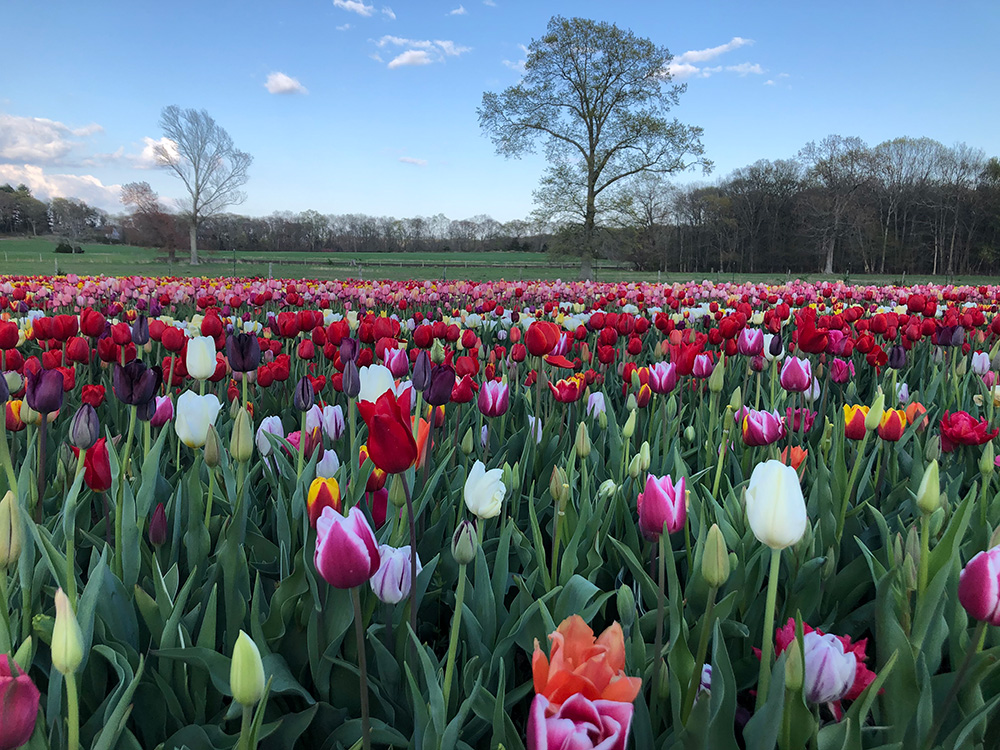

In this blog, we explore how Connecticut’s greenhouses, nurseries, farms, and garden centers are excellent places to visit during the spring. Whether you’re looking to improve your home or simply want a memorable experience, you’ll find something that’s right for you.
Greenhouses, nurseries and garden centers
Throughout the winter, Connecticut’s greenhouse and nursery producers have been busy sowing seeds, potting plants, and preparing to assist customers in the new growing season. By visiting a CT Grown greenhouse or nursery, you’ll receive:
- Expert guidance: Whether you’re trying to liven up a shady spot or need advice on growing a specific plant, greenhouse and nursery producers can offer expert advice and care plans tailored to your own property.
- Educational opportunities: The spring season often brings workshops and other educational opportunities at greenhouses and nurseries. Attendees can learn about seed starting, container gardening, composting, and much more.
- Great deals: To encourage people to pursue the big plans they have for their garden, nurseries and landscapes may offer discounts or open up loyalty programs at the beginning of the spring season. Take advantage of these to enjoy savings throughout the year.
- New inspirations: A visit to a garden or nursery can inspire a new vision for your home. Discover new plant options and features that can transform your rooms or landscaping.
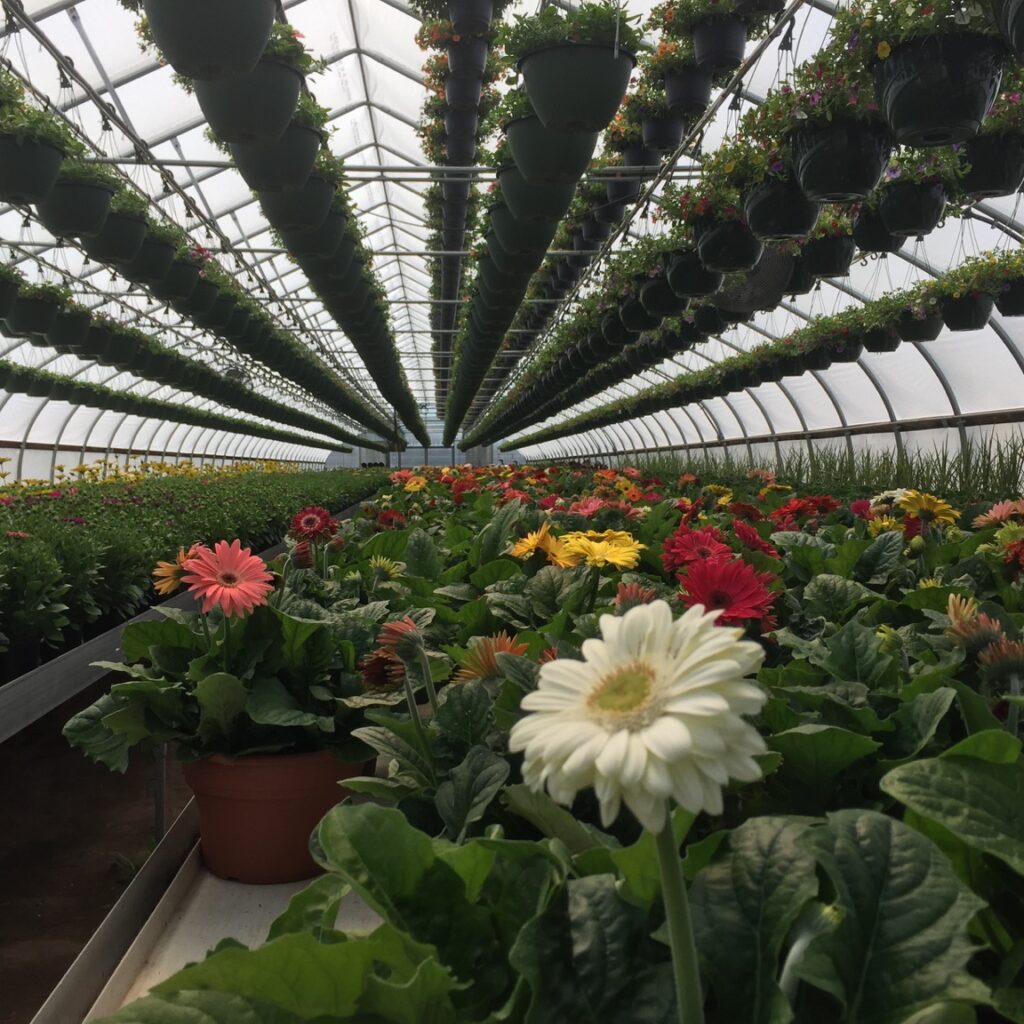
There’s no shortage of products available at greenhouses and nurseries to get a jump on the year’s gardening plans, including:
- Annual flowers: Although annuals only last a single season, they add a welcome pop of color to your garden and are easy to care for. Some of the annuals available in spring include Easter lilies, impatiens, marigolds, pansies, and petunias.
- Perennial flowers: Perennials return year after year, making them an easy option for long-term garden planning. Some spring perennial choices include coneflowers, daylilies, and hostas.
- Shrubs: A useful choice for boundaries or privacy barriers, shrubs can also create beautiful landscaping and support pollinators when you choose flowering varieties like butterfly bushes, hydrangeas, and viburnums.
- Fruiting trees: Add a small orchard alongside your vegetable garden using varieties like apple and cherry trees.
- Vines: Transform vertical surfaces into part of your garden using vining plants like clematis and honeysuckle.
- Vegetable starts and seedlings: Plants that have been sown indoors — including eggplants, herbs, peppers, and tomatoes — let you get a jump on the year’s harvest.
Walk-through flower experiences
Some farms in Connecticut give visitors an up-close look at the returning floral landscape by offering walk-through experiences. Visitors can stroll through the fields and marvel at the spectacle of thousands of flowers in bloom together.
In a relaxing, meditative experience, visitors are surrounded by the visual beauty and delightful scents of a sea of flowers. These scenes are also a popular photographic backdrop for everything from family portraits to engagement shots.
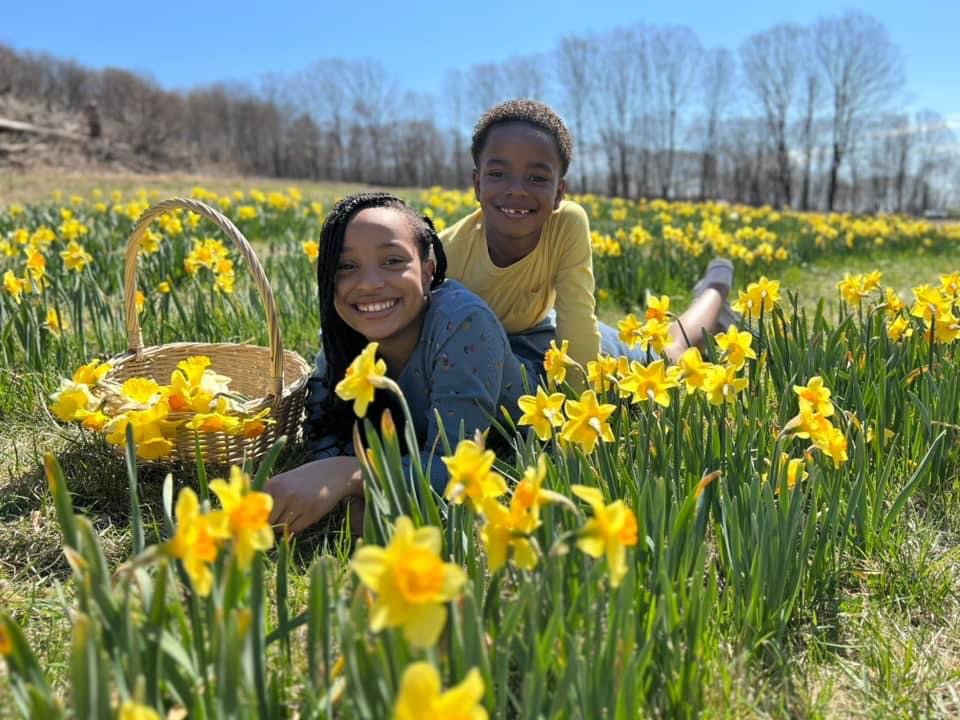
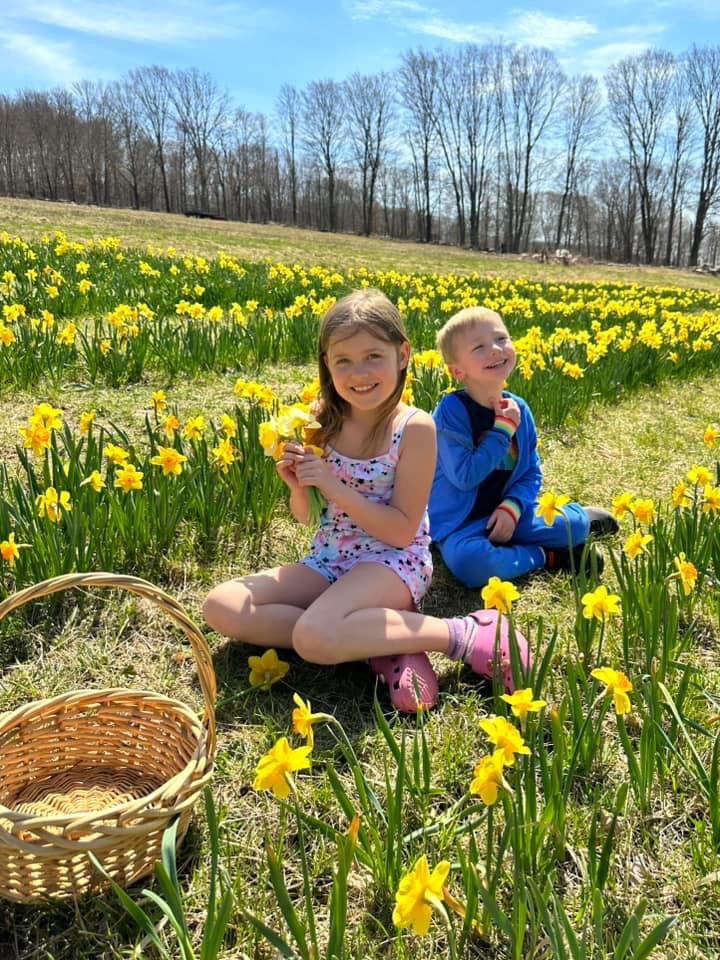

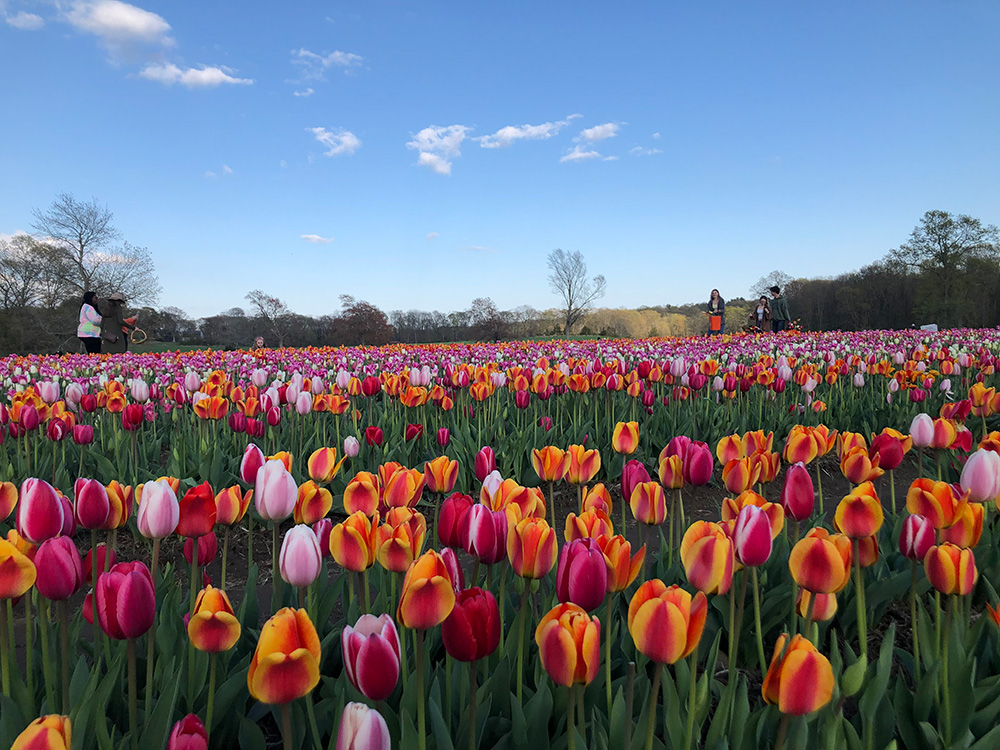
Walk-through flower experiences are often paired with pick-your-own options that let you take home a beautiful bouquet. Some options in Connecticut include:
- Halfinger Farms (Higganum): Every year, “Dancing Daffodils” at this farm lets visitors visit a field of these brilliant yellow flowers and pick their own selection. Halfinger Farms hosts several special events alongside the daffodil season, while also raising additional flowers such as peonies, violas, and mums.
- Lavender Pond Farm (Killingworth): Denise Salafia established this farm as a tribute to her mother, who died of breast cancer. Today, it invites visitors to walk through the fields as thousands of lavender plants come into bloom.
- Wicked Tulips (Preston): One of three locations growing a total of more than 1.5 million tulips, Wicked Tulips gives visitors the one-of-a-kind experience of walking through a vast field of these flowers during their brief but awe-inspiring time in bloom.
- Willow View Farm (West Suffield): Along with thousands of ornate dahlias, this farm lets visitors pick a selection of varieties that include daffodils, peonies, and tulips.
Cut flower CSAs
Community Supported Agriculture (CSA) programs go well beyond the traditional shares of fruits and vegetables, and Connecticut’s thriving floriculture businesses mean that there are plentiful options to find cut flower CSAs. Farms may offer these options either on their own or as an optional add-on to another CSA.

Spring flower CSAs are an excellent choice for people who can’t wait to get fresh flowers back into their home after a long winter. These feature seasonal flowers such as alliums, anemones, canterbury bells, daffodils, hyacinths, narcissus, ranunculus, and tulips. Farms often grow specialty varieties that aren’t usually found in stores, allowing each farm to create bouquets with a distinctive look.
Cut flower CSAs continue into summer and autumn, with each new share changing based on what’s in season. Some farms may also offer these CSAs into the winter, featuring greenhouse-grown flowers.
To find a cut flower CSA near you, visit the CT Grown map.
The new harvest season will be here before you know it, and there’s still time to sign up for a CT Grown CSA! By joining a Community Supported Agriculture program this winter, you’ll receive regular shares of fresh, nutritious food for months to come.
Read more about your CSA options in our latest newsletter, or visit one of these resources to learn more:
- CT Grown CSAs: A Win-Win for Farmers and Consumers
- Meat, Flowers…Seaweed? Explore CT Grown’s Non-Traditional CSA Options
- CT Grown Map: Find a CSA Near You
It’s a season for families to come together and celebrate the holiday spirit. And when everyone from the grandparents on down to little grandchildren are together under one roof, that means it’s time for another big feast!
CT Grown products are a great choice for the family gathering. You’ll also need something to wet your whistle, though, and Connecticut’s farmers have you covered there as well! Check out these options, and raise a glass to CT Grown for the holiday season!
Eggnog

Like many traditional holiday dishes or beverages, eggnog was once considered a luxury due to the priciness of many of its ingredients. Families would splurge on the drink — and other delicious items — and hold toasts to wealth and prosperity in the new year.
Although eggnog is no longer considered a luxury, these toasts have remained — along with the seasonal availability of the beverage, which could conceivably be offered year-round. Eggnog is a thick, sweet drink that mixes milk, cream, sugar, egg yolks, and whipped egg whites.
Several Connecticut dairy farms get in on the holiday spirit by producing eggnog at this time of year. You can enjoy it plain, or spike it with alcohol like rum or bourbon.
This is also the only time of year you can test it out in other ways! Try eggnog as a coffee creamer, or use it as a milk substitute in recipes for waffles, pancakes, and cookies.
Coquito

Spanish for “little coconut,” coquito is also referred to as Puerto Rican Eggnog due to its popularity on the island. As a tropical tradition, many of its ingredients — including coconut milk, coconut cream, and vanilla — aren’t exactly CT Grown.
However, you can still use yolks from locally sourced eggs and mix them with condensed milk (a product invented in Connecticut, incidentally) to make a thick base for this drink. Add in some rum from a Connecticut distillery as well!
Whiskeys and spirits
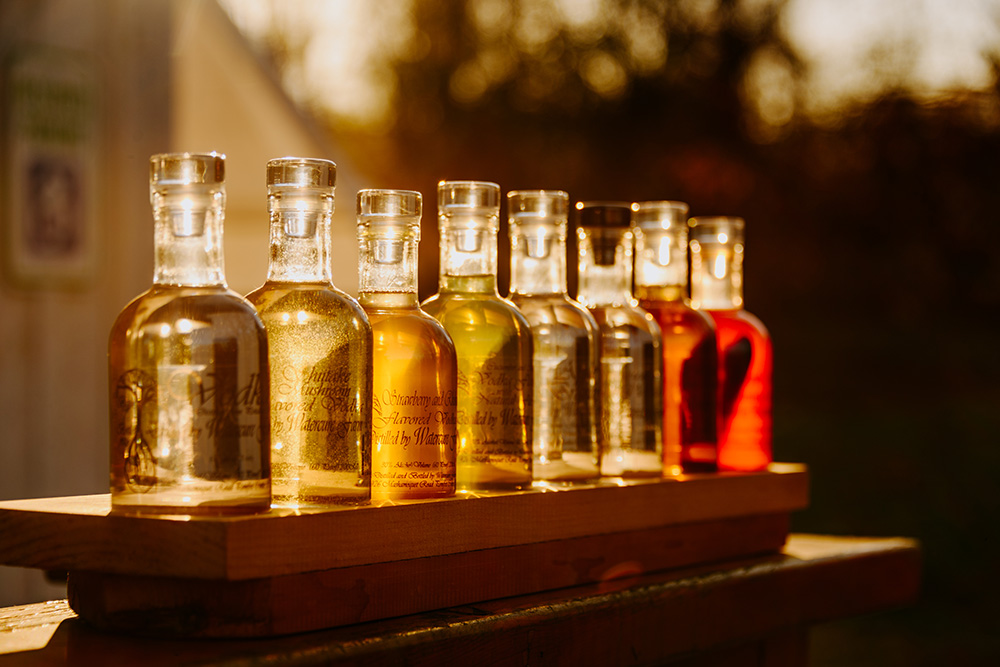
A growing number of distilleries in Connecticut are giving residents and visitors a local option when it comes to bourbon, gin, rum, vodka, whiskey, and other spirits. These distilleries frequently partner with local farms to infuse their product with flavors like fruit and herbs.
During the holiday season, you can relax with warming drinks like a hot toddy, hot buttered rum (using CT Grown butter, of course), spiked hot chocolate, or a nor’easter — a winter spin on the Moscow Mule that includes maple syrup in the mix.
Wine
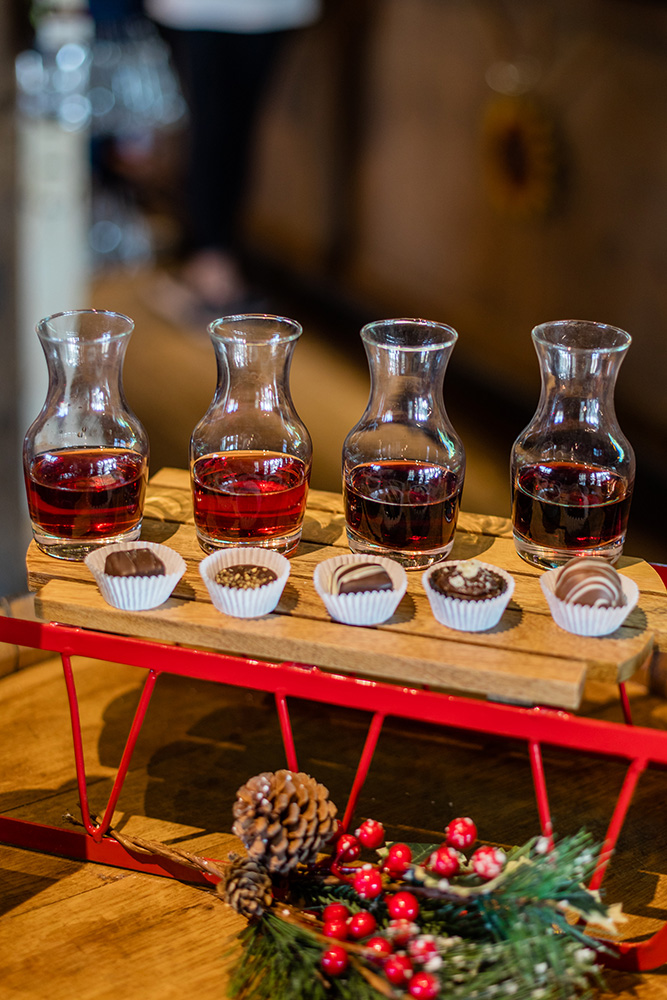
Some of Connecticut’s 45 farm wineries close their doors for the season when colder temperatures arrive, but many are happy to welcome guests throughout the year. Pull up a seat in the cozy tasting room to enjoy some delicious vintages, and pick up a bottle or two as a gift.
Connecticut farm wines also work well for mulling to create a delicious, warm beverage on a holiday evening. Mulled wine is prepared with ingredients like oranges, honey, and spices for a wonderful evening libation.
Wassail
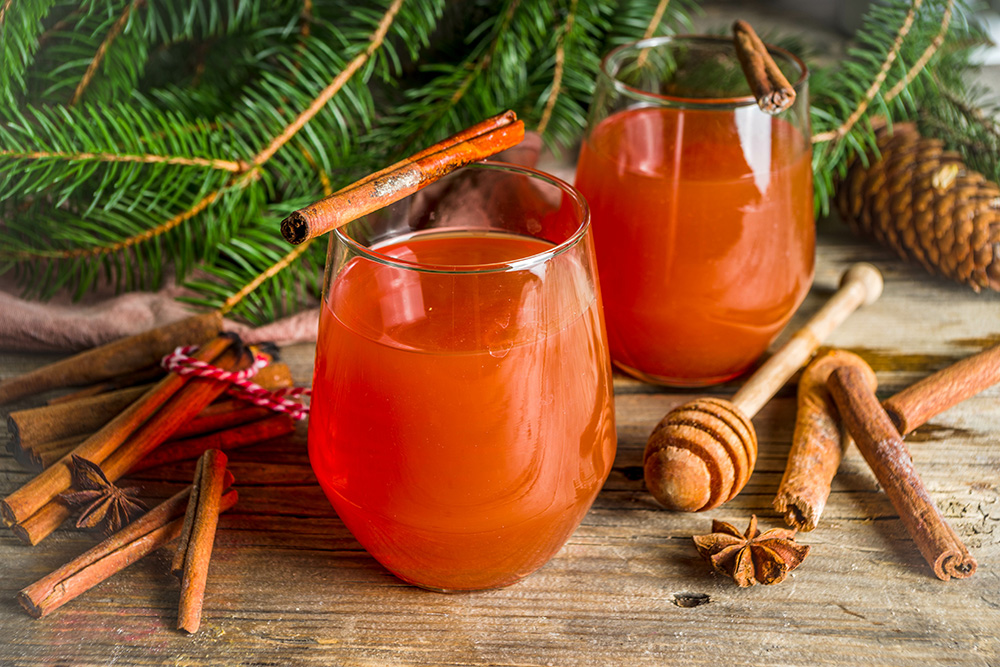
Yes, the drink from the Christmas song!
Traditionally held on Twelfth Night, wassailing involves a group of people visiting homes to sing festive tunes and wish the occupants good cheer. The homeowner rewards them with a small gift (a figgy pudding, perhaps) in exchange for the group’s blessings and a drink from the bowl of wassail they carried. In addition to the neighborhood strolls, wassailing ceremonies have also taken place in orchards to bless the trees before the next season.
Although caroling has largely replaced wassailing, the beverage remains a unique holiday offering — and one that can easily use CT Grown ingredients. Wassail is traditionally made with a base of cider, ale, or wine, which is then mulled with spices.
Beer
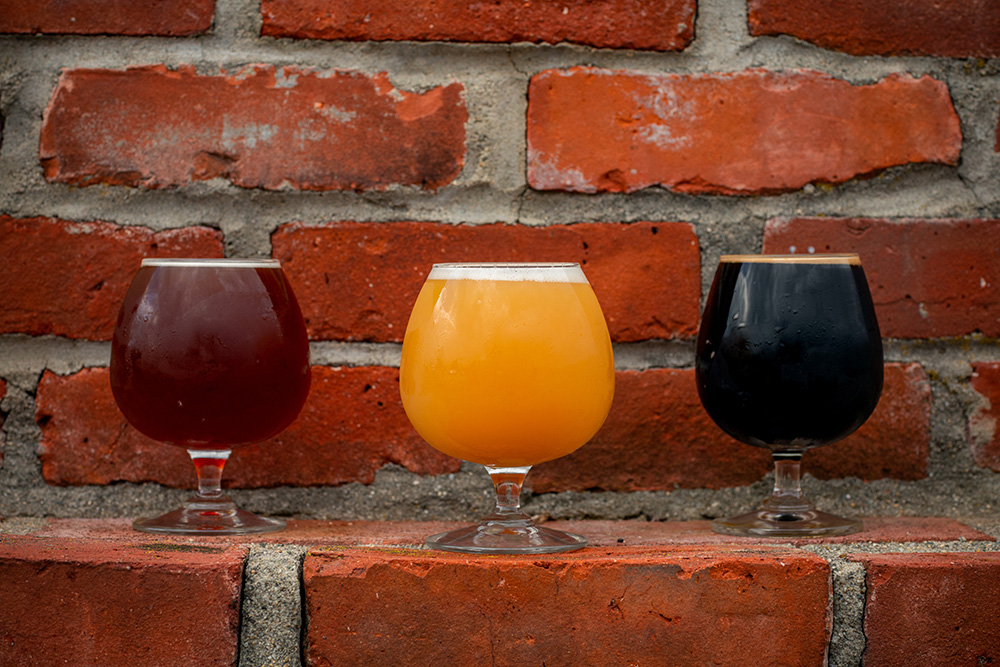
Connecticut’s craft breweries are in operation year-round. But once winter arrives and patrons abandon the beer garden for the toasty taproom, the preferred styles shift to heartier fare.
“Winter warmers” such as porters and stouts typically use darker malts, have a higher alcohol by volume (ABV), and are more filling. In addition, many breweries celebrate the season by creating holiday ales with ingredients like cinnamon, orange peel, and other flavors found in mulled drinks.
You may also find a greater availability of imperial beer options, which have stronger, heartier flavors that may be further enhanced through barrel aging. These beers also have a very high ABV, so be sure to drink responsibly.
Cider
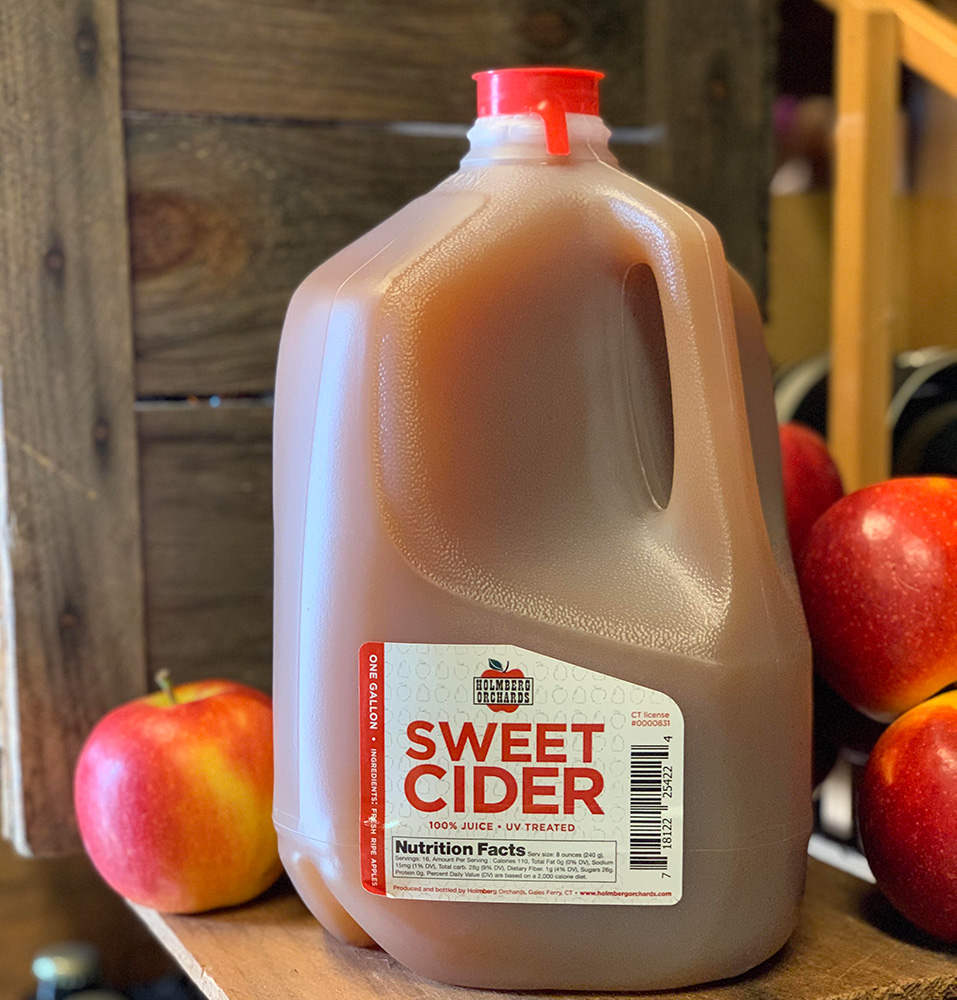
This autumn favorite is still available during the holidays, though this is also your last call for the delicious beverage. Apple cider is a dark, sweet beverage produced by compressing apple mash; since it lacks preservatives, it has a shorter shelf life and more seasonal availability compared to apple juice.
Warm up with apple cider on a cold evening by mulling it with honey, maple syrup, or spices. You can also look for some of the hard cider options offered by many orchards, which often have varieties pairing the alcoholic beverage with flavors like honey and ginger.
Milk for Santa

You can’t forget Saint Nick this time of year. Locally produced milk is available from 87 dairy farms in Connecticut, and leaving out a glass of milk for Santa ensures that he’ll get 13 essential nutrients with every serving.
December 9, 2023 @ 9:00 AM – 2:00 PM
This event aims to bring together Connecticut’s agricultural producers, construction industry, innovators in materials and manufacturing, regulators, and community groups working on regenerative urban developing and agriculture to discuss possibilities and avenues to further circular regenerative hemp production, construction and use.
The program will discuss topics including developing farm capacity for hemp, adding value to agricultural land use, and BIPOC liberation through circular economic development.
Related Events
March 23 @ 8:00 AM – 8:00 PM
CT NOFA is proud to present our 42nd Winter Conference, featuring a series of virtual workshops on March 20-21 in the lead up to our full day, in-person gathering and celebration on March 23, 2024 at Eastern Connecticut State University, in partnership with their Institute of Sustainability.
Related Events
March 14 @ 9:00 AM – 5:00 PM
The CT Compost Alliance is excited to announce that the first CT Compost Conference. This informative day will include keynote speakers, breakout sessions, networking, a catered lunch, and exhibitors. Attendees will benefit from a variety of themed breakout sessions, providing education on composting related to the basics, home, farm, municipal, schools, and medium to large scale operations. The event will highlight how composting can benefit local communities, businesses, the environment, and improve climate resiliency.
Related Events
January 29 @ 9:00 AM – 3:00 PM
Presentations on the state of the grainshed, agronomic data, and where we see the future of Northeast grains going. Agenda topics include grain varieties in our region, local grain in schools, regenerative grain farming, and more. The symposium features speakers from local farms and the Universty of Vermont Extension.
Registration is $30 for virtual members, $50 for members and virtual non-members, and $80 for in-person non-members.
Related Events
January 9 @ 8:00 AM – 3:30 PM
This event is a valuable resource for local farmers who are seeking connections in the state as well as knowledge about local issues and opportunities. A trade show will be held throughout the conference, and 4 CEU pesticide recertification credits are available.
Registration is $40 before noon on December 20th, 2023 and $60 afterward. Registration for matriculated students with a valid ID is $30.
